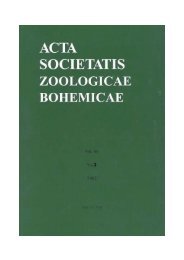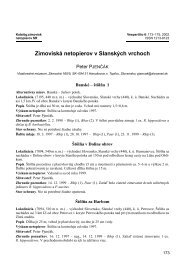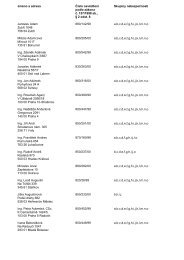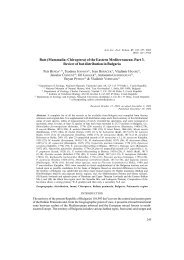Untitled
Untitled
Untitled
Create successful ePaper yourself
Turn your PDF publications into a flip-book with our unique Google optimized e-Paper software.
Bulletin of the Czech Geological Survey, Vol. 77, No. 4, 243–252, 2002<br />
© Czech Geological Survey, ISSN 1210-3527<br />
Asteroids: Their composition and impact threat<br />
THOMAS H. BURBINE<br />
Department of Mineral Sciences, National Museum of Natural History, Smithsonian Institution, Washington, DC 20560-0119, USA; e-mail:<br />
burbine.tom@nmnh.si.edu<br />
Abstract. Impacts by near-Earth asteroids are serious threats to life as we know it. The energy of the impact will be a function of the mass of<br />
the asteroid and its impact velocity. The mass of an asteroid is very difficult to determine from Earth. One way to derive a near-Earth object’s mass is<br />
by estimating the object’s density from its surface composition. Reflectance spectra are the best way to determine an object’s composition since many<br />
minerals (e.g. olivine, pyroxene, hydrated silicates) have characteristic absorption features. However, metallic iron does not have characteristic absorption<br />
bands and is very hard to identify from Earth. For a particular size, asteroids with compositions similar to iron meteorites pose the biggest<br />
impact threat since they have the highest densities, but they are expected to be only a few percent of the impacting population. Knowing an asteroid’s<br />
composition is also vital for understanding how best to divert an incoming asteroid.<br />
Key words: Earth, asteroids, impact features, meteorites, mineral composition, geologic hazards<br />
Introduction<br />
As we enter a new millennium, we are constantly being<br />
bombarded with news of close encounters with near-Earth<br />
objects (NEOs). Observers have discovered over 2,000 near-<br />
Earth asteroids (NEAs); luckily none are known to be on a<br />
collision course with the Earth. Comets are also serious impact<br />
threats as shown by the collision of Shoemaker-Levy-9<br />
with Jupiter in 1994. Since the discovery of the iridium<br />
anomaly at the Cretaceous-Tertiary (K-T) boundary layer by<br />
Alvarez et al. (1980), there has been a considerable discussion<br />
of the possibility and consequences of such an impact<br />
(e.g. Chapman and Morrison 1994, Adushkin and Nemchinov<br />
1994, Toon et al. 1997, Garshnek et al. 2000).<br />
As we discover more Earth-approaching asteroids, we<br />
are also learning more about their compositions and structure.<br />
Charge-coupled devices (CCDs) now allow us to obtain<br />
visible and near-infrared telescopic spectra of<br />
near-Earth asteroids that are a few hundred meters or<br />
smaller in diameter (e.g. Binzel et al. 2001a). Technological<br />
improvements to the radio telescope at the Arecibo Observatory<br />
have allowed similarly sized objects to be<br />
characterized by radar (e.g. Ostro et al. 2002). Spacecraft<br />
missions now show asteroids to be geologic bodies with a<br />
variety of morphologic features. More meteorites are discovered<br />
every year and are being extensively studied in the<br />
laboratory with more precise analytical techniques.<br />
However as we continue our research on asteroids, a<br />
number of questions should be asked. “How do asteroid<br />
compositions affect the impact threat?” “How well can we<br />
determine asteroid compositions from Earth?” This paper<br />
will review what we currently know about asteroid compositions<br />
and how it affects the impact threat. Since we<br />
have not yet returned any samples from any asteroids, our<br />
knowledge of asteroid compositions is derived from analyses<br />
of meteorites, remote sensing observations from Earth,<br />
and spacecraft missions.<br />
Impact threat<br />
I will first briefly review what we know about the number<br />
of near-Earth objects and the energy and effects of impacts.<br />
The near-Earth object population is defined as small<br />
bodies with perihelion distance less than 1.3 AU (astronomical<br />
units) and aphelion distance greater than 0.983<br />
AU (Morbidelli et al. 2002). These objects are primarily<br />
thought to be asteroids ejected from the main belt; however,<br />
a few extinct comets probably exist in the population.<br />
Recent estimates of the numbers of NEAs larger than one<br />
kilometer in diameter vary from 855 (±110) (Morbidelli et<br />
al. 2002) to 1227 (uncertainties of +170 and –90) (Stuart<br />
2001).<br />
The kinetic energy (E) of an incoming asteroid is<br />
(1/2)mv 2 where m is the mass and v is the velocity. Mass is<br />
a function of the density (ρ) and volume (V) of the object.<br />
Since the energy of an impact is usually given as megatons<br />
of TNT, the kinetic energy equation can be written (Morbidelli<br />
et al. 2002) as<br />
E = 62.5 ρd 3 v 2<br />
where E is in megatons, ρ is in g/cm 3 , d is the diameter of<br />
the impactor in kilometers, and v is in km/s. The average<br />
impact velocity for asteroids with Earth are ~ 20 km/s (e.g.<br />
Hughes, 1998). Comets have lower densities (estimated to<br />
be around ~ 1 g/cm 3 ), but some long-period comets have<br />
much higher average impact velocities (~ 55 km/s) (Marsden<br />
and Steel 1994). Since water covers approximately<br />
three-fourths of the Earth’s surface, “large” impacts are<br />
likely to cause tsunamis (e.g. Paine 1999), giant tidal<br />
waves created by sudden disturbances.<br />
The best-characterized localized catastrophe is the impact<br />
at Tunguska where an object exploded 5–10 km in the<br />
air over an uninhabited region of Siberia (e.g. Chyba et al.<br />
1993, Vasilyev 1998). The energy was estimated to be<br />
~ 10–20 megatons and devastated an area of ~ 2000 km 2<br />
of forest area. In comparison, the energy is ~ 1,000 times<br />
243








